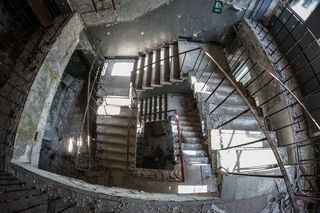Depression
Castles of Despair: Hollywood's Asylums
How Tinseltown shapes our ideas about mental hospitals.
Posted May 6, 2019
The opening of Milos Forman’s classic One Flew Over the Cuckoo’s Nest offers a scene of stark desolation. As dawn slowly creeps over a mountainous plain, a car slides across an empty highway. Next, we see a series of sleeping patients, the camera briefly settling over a drawing of what appears to be a man screaming. This is followed by the infamous Nurse Ratched arriving through a grated metal door. Played with cold calculation by Louise Fletcher, Ratched is all business in her black overcoat and hat. The music is weird and creepy. We know we have entered a scary, prison-like place.
One Flew Over the Cuckoo’s Nest has been blamed for many things—the decline of admissions to public institutions, the stigmatization of electroconvulsive therapy, the upending of committal laws, and even the disparagement of tough, independent women. There is definitely something to all of this. Not for nothing did the Royal College Psychiatrists grumble that Cuckoo’s Nest and similar films “did for ECT what Jaws did for sharks.”
As an historian who has spent some time with this topic, I can say with authority that Forman’s movie is not quite so revolutionary. It is, rather, a link in a very long chain. From the scary dungeon in 1904’s The Escaped Lunatic up through Jazz Age nightmares like The Monster (1925) and Dracula (1931) and beyond, Hollywood has been scaring us with mental institutions. Prior to Cuckoo’s Nest, the most famous asylum film was 1948’s The Snake Pit, which exposed audiences to shocking scenes of despair and institutional rot. This movie was so disturbing that “snake pit” became a cultural catchphrase for mental hospitals.
For over a century, Hollywood has been telling us that "asylums" (as they are inevitably called) are scary, isolated horror factories peopled with deranged psychopaths, social rebels, brutal employees, and mad-scientist psychiatrists. ECT is Frankenstein-style electrocution, ice pick lobotomies are de rigueur, restraints are punishments, and hydrotherapy is water torture. In these high-walled castles or factory-like warehouses, often introduced on rainy nights, bad things happen.
I have spent years watching and analyzing asylum movies. What I can share from my experience is this—when we see celluloid asylums, we are seeing a standardized product.

The Hollywood asylum is a cumulative invention. Once a movie succeeds, its properties are retained and passed on to later films, Darwin-style. As Andrew McDonald and Gerry Walter explain, for instance, depictions of ECT have become worryingly formulaic. “Although unmodified ECT has obvious dramatic potential,” they note, “one begins to suspect that much of the medical research in these films involved watching how ECT was performed in earlier movies.” The ECT scene in Cuckoo’s Nest is frightening and realistic. It also borrows from earlier depictions and neglects the then-widespread use of anesthetics.
I’ve found similar formulae for padded cells, lobotomies, psychiatrists, hallways, basements, doctors, nurses, attendants, and buildings. Hollywood is so practiced in these elements that we can now have transorbital lobotomies in Victorian England (From Hell), anachronistic ECT in 1920s Los Angeles (Changeling), and even treatments almost too deranged to believe (power drill lobotomy, anyone?). Thanks to this process, when we think of mental hospitals, we most likely reference movies and TV shows rather than real places.
Is this a bad thing? After all, isn’t it all just entertainment? Certainly, One Flew Over the Cuckoo’s Nest is by most (including my own) accounts a cinematic masterpiece. Further, I’d suggest it effectively created a conversation regarding intractable problems of institutional inertia and bureaucratic dreadfulness. Many psychiatrists recommended it—even the staid journal The Lancet endorsed it when it came out. But the problem, as numerous studies demonstrate, is that mental hospitals are portrayed so negatively that many people suffering mental illness decline to seek treatment. Carrie Fisher captured this vividly when recounting her own resistance to getting help. Though doctors recommended ECT for her depression, “My only exposure to it was Jack Nicholson in One Flew Over the Cuckoo’s Nest…From the seizures to the biting down on a stick to the convulsions, it looked traumatic, dangerous, and humiliating. I mean what do we know for certain about it? Aren’t there a bunch of risks? What if something goes wrong and my brain blows up?” These are Hollywood-nurtured fears.
Fisher ultimately decided to undergo electroconvulsive treatment. It was, she explained, either “ECT or DOA.”
References
Fisher, C. (2008). Wishful Drinking. New York, NY: Simon and Schuster.


